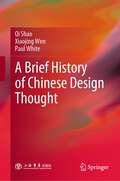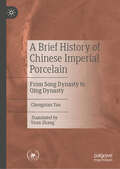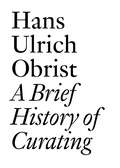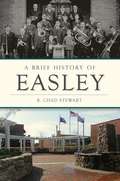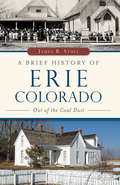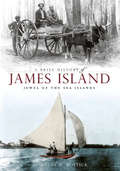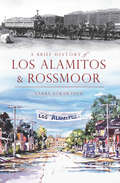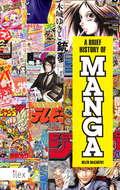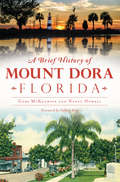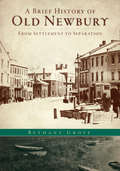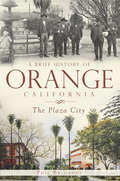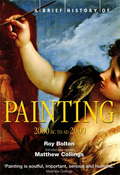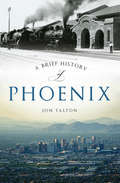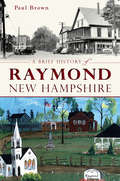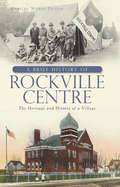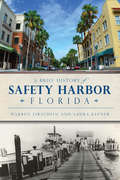- Table View
- List View
A Brief History of Chinese Design Thought
by Paul White Qi Shao Xiaojing WenThis book introduces readers to the history of design thinking in pre-modern China. The content is structured according to successive dynasties, covering the seven major periods of the pre-Qin, Qin and Han, Wei and Jin, Sui and Tang, Song and Yuan, Ming, and Qing dynasties. Each chapter introduces the most representative individuals of the period and discusses their work and ideas in order to reveal the national and cultural features of the respective periods. A distinctive feature of cultural identity running through the long course of China’s historical development is the argument that actions are determined by ideas: Such a view can be found in long-standing thinking on art, design, and creativity. The book demonstrates that conscious design is the vital link between the ideas that constitute human cultures and the physical objects that make up their resulting material cultures. It is the attribute of design that defines what it is to be human and also produces the physical evidence of the evolution of Chinese civilization. The book reveals the integrated characteristics of Chinese culture and art and shows how both changing and recurring ideologies have influenced Chinese design practice since the ancient Shang and Zhou dynasties and how these forces have shaped the spirit and materiality of Chinese civilization. Design is the cornerstone that has made China one of the major contributors to human civilization throughout the thousands of years of its history.Given its focus, the book largely appeals to two main audiences: an academic readership of students and researchers interested in cultural studies and, a more general one, consisting of those interested in international comparisons and wishing to learn more about Chinese history, society, and culture. In order to appeal to both, the book is written in a clear and accessible language.
A Brief History of Chinese Imperial Porcelain: From Song Dynasty to Qing Dynasty
by Chongnian YanThis book provides a unique history of the Porcelain Road against the backdrop of Chinese and Western cultural exchanges. Written by one of China’s most influential scholars, it introduces the history of Chinese Porcelain, especially the history of the imperial porcelain kiln, taking the most representative porcelain of each period as examples, and examining relevant historical background. Studying artifacts from well-known collections such as the Palace Museum, Taipei Palace Museum, Shenyang Palace Museum, Nanjing Museum, this text offers a unique discussion of China’s porcelain culture and history, and will be of relevance to all those interested in one of the key aspects of Chinese culture and cultural exchanges between East and West.
A Brief History of Curating
by Hans Ulrich ObristPart of JRP|Ringier's innovative Documents series, published with Les Presses du Réel and dedicated to critical writings, this publication comprises a unique collection of interviews by Hans Ulrich Obrist mapping the development of the curatorial field--from early independent curators in the 1960s and 70s and the experimental institutional programs developed in Europe and the U.S. through the inception of Documenta and the various biennales and fairs--with pioneering curators Anne D'Harnoncourt, Werner Hoffman, Jean Leering, Franz Meyer, Seth Siegelaub, Walter Zanini, Johannes Cladders, Lucy Lippard, Walter Hopps, Pontus Hulten and Harald Szeemann. Speaking of Szeemann on the occasion of this legendary curator's death in 2005, critic Aaron Schuster summed up, "the image we have of the curator today: the curator-as-artist, a roaming, freelance designer of exhibitions, or in his own witty formulation, a 'spiritual guest worker'... If artists since Marcel Duchamp have affirmed selection and arrangement as legitimate artistic strategies, was it not simply a matter of time before curatorial practice--itself defined by selection and arrangement--would come to be seen as an art that operates on the field of art itself?" This is the ebook edition of A Brief History of Curating, originally published in print form in October, 2008.
A Brief History of Easley (Brief History)
by R. Chad StewartEasley has a rare combination of a quaint Main Street and a thriving industrial presence. The city was a series of small farms and open land until residents convinced officials to make the area a stop along the Atlanta and Richmond Air-Line Railroad after the Civil War. Access to the railroad and the popularity of cotton spurred an era of rapid growth and expansion, culminating in the dominance of the textile industry throughout most of the twentieth century. While cotton drove textiles in the area, advances in agriculture and manufacturing brought dozens of companies, placing Easley at the center of the state’s biggest industrial area. Author Chad Stewart details the history of a city that moved from sleepy train stop to vibrant South Carolina city.
A Brief History of Eastham: On the Outer Beach of Cape Cod (Brief History)
by Don WildingFirst known as Nauset, Eastham once reached across the eastern half of Cape Cod from Bass River to the tip of what is now Provincetown. The area was home to the Nauset tribe for thousands of years before exploration by Champlain and the Pilgrims, and it is now known as the “Gateway to the Cape Cod National Seashore.” Whether it’s the U.S. Life-Saving Service and its shipwreck rescues, Cape Cod’s oldest windmill or tales of sea captains and rumrunners, Eastham is truly rich in history and tradition. Author Don Wilding wanders back in time through the Outer Cape’s back roads, sand dunes and solitary beaches to uncover Eastham’s fascinating past.
A Brief History of Eastvale (Brief History)
by Kim Jarrell Johnson Loren P. MeissnerThe vibrant and beloved community of Eastvale was once an agrarian paradise. Developed initially as ranchlands, this area tucked along the Santa Ana River was transformed by industrious farmers who produced alfalfa and other crops, raised poultry and eventually thrived as dairymen. Eastvale's latest agents of change, however, weren't cattlemen or farmers but real estate agents. Indeed, land developers saw the same potential in Eastvale as the initial ranchers did. Beginning in the 1990s, developers created charming homes and planned neighborhoods for former city dwellers eager to live in Riverside County. Despite the changes, the bucolic ambiance of the bygone era remains. Authors Loren P. Meissner and Kim Jarrell Johnson recount the dynamic changes, important people and exciting events that created Eastvale.
A Brief History of Erie, Colorado: Out Of The Coal Dust (Brief History)
by James B. StullFrom 1866 until 1979, Erie was one of the largest coal-producing towns in the nation. Numerous settlers contributed to building Old Town and making it one of the liveliest communities in northern Colorado. The Columbine Mine massacre in 1927 incited major changes to coal mining practices, inspiring unionization efforts nationally. The improved rights and working conditions that miners struggled to win benefit employees across America today. Emeritus Professor James B. Stull illuminates Erie's earliest pioneers, houses, schools and churches and the town's enduring evolution.
A Brief History of Fairplay (Brief History)
by Linda BjorklundExplore Fairplay from the beginning with local historian Linda Bjorklund as she traces the town's story through Spanish settlers, early American government, Union-Confederate tensions and modern development. Even though Fairplay's remarkable gold and silver boom was reduced to ash overnight in 1873, a strong community overcame history's challenges and preserved its treasures. From the popular annual Burro Days to the Way of Life Museum, Fairplay gives folks a chance to celebrate and relive its rich mining history through festivities and time-capsule buildings such as the general store, drugstore, bank, Summer Brewery and Summer Saloon.
A Brief History of Image Science and Technology in China
by Congyao HanThis book, within the vision of the study on the image history, clearly manifests the development of Chinese image science and technology of over 2000 years based on compendium, while having briefly sorted out expositions by scientists since ancient times in China, demonstrates the spiritual course, ideas of thinking and forms of life and reveales profound humane ideas, basis of sentiments and styles of the spirit featured by Chinese image culture. The historic outline of images is clear-cut along with authenticated inter-attestation for clues of images and texts. Historic facts concerning images are ecologically diversified, while historic documents about images are properly chosen, in addition to the integration between liberal arts and science and perfect combination between images and texts. Blessed with nice integration between images and texts, this book serves as reference to experts, scholars, undergraduates and postgraduates related to the study on image history, history of science and technology, study of history and news communication.
A Brief History of James Island: Jewel of the Sea Islands (Brief History)
by Douglas W. BostickIn this engaging volume, local historian Douglas Bostick reveals the unacknowledged history of the second community in South Carolina, settled in 1671. Whether investigating prehistoric clues about Native American life before European settlement, detailing the history of agriculture and the reign of King Cotton, following armies from multiple wars or chronicling the triumph of equality on the greens of Charleston's Municipal Golf Course, Bostick tells the story of James Island as only a native son can. Join Bostick as he brings this small jewel of an island out of Charleston's shadow and into the light of its own rich, historic assets.
A Brief History of Los Alamitos-Rossmoor
by Larry StrawtherThe city of Los Alamitos and the contiguous, unincorporated community of Rossmoor exemplify small-town America amid the populous western Orange County sprawl. Their tree-lined streets, well-kept homes and first-rate schools are reflected in Rossmoor's selection as the No. 1 suburb in California (and No. 9 nationwide) in a 2012 study by Coldwell Banker Realty. The evolution of Los Alamitos from cattle ranches and sugar beet factory town to World War II military town and ultimately into residential neighborhoods took a century. Meanwhile, the planned "walled 'city' of Rossmoor" was created between 1955 and 1961. Despite annexation talk, Rossmoor and "Los Al" coexist apart together, so to speak, on Long Beach's outskirts. Author Larry Strawther traces the histories of these interdependent sister communities, which epitomize the reality in the legend of the Orange County lifestyle.
A Brief History of Manga: The Essential Pocket Guide To The Japanese Pop Culture Phenomenon
by Helen McCarthyManga is more than a genre in the comics field: it is a vital creative medium in its own right, with hundreds of millions of readers worldwide, a host of graphic styles, and a rich history now spanning seven decades.Now for the first time, that history is told by an award-winning expert in the field. Covering topics from Akira to Mazinger Z, this book is fully illustrated throughout, and photos of key creators accompany accessible sidebars and timelines.Answering the key questions of any fan where did my favourite manga come from, and what should I read next? this book will open doors to neophytes and experts alike.
A Brief History of Manga: The Essential Pocket Guide To The Japanese Pop Culture Phenomenon
by Helen MccarthyManga is more than a genre in the comics field: it is a vital creative medium in its own right, with hundreds of millions of readers worldwide, a host of graphic styles, and a rich history now spanning seven decades. Now for the first time, that history is told by an award-winning expert in the field. Covering topics from Akira to Mazinger Z, this book is fully illustrated throughout, and photos of key creators accompany accessible sidebars and timelines. The text is chronological, telling the story of Manga from its early-20th-century origins to its global dominance. Timelines relate key publications to events in Japanese and World history, and frequent sidebars give short biographies of key creative figures. Answering the key questions of any fan - where did my favourite manga come from, and what should I read next? - this book will open doors to neophytes and experts alike. Fans of manga and anime will: - discover the stories behind their favorite manga creator - be inspired by the history of the medium and its genre - find new manga to read and fall in love with
A Brief History of Mount Dora, Florida (Brief History)
by Nancy Howell Gary MckechnieMount Dora is known for its southern charm and New England look, yet its history is just as engaging. The "Festival City" began with the arrival of pioneer families such as the Drawdys, Simpsons and Tremains. In the 1880s, it became a popular destination for Chautauqua events, when visitors gathered beside Lake Gertrude and Lake Dora for educational and cultural enrichment. In the twentieth century, Mount Dora weathered economic setbacks and racial conflict before becoming a premier city of the arts. Today, this beautiful lakefront community welcomes thousands of visitors to its numerous festivals, events and active shopping village. Join authors Gary McKechnie and Nancy Howell as they celebrate the intriguing history of their town.
A Brief History of Norco (Brief History)
by Kevin Bash Angelique BashLegend has it that Rex Clark won fifteen square miles of failed farms, rutted roads and broken water mains in a poker game. Using his wife's newspaper fortune, Clark tried orchards and then poultry. Local hot springs inspired Clark's creation of a giant recreational resort. U.S. presidents and Hollywood royalty sojourned at the fabulous Norconian until the Great Depression hit. The spa was converted to U.S. Naval Hospital #1 during World War II and then a top Cold War missile lab. Norco became a horse-raising enclave while staving off annexation from nearby southwestern Riverside County cities. Today, the city is known nationwide as HorseTown, USA. Join former mayor Kevin Bash and his coauthor daughter Angelique Bash for this engaging trail ride through Norco's colorful past.
A Brief History of Old Newbury: From Settlement to Separation
by Bethany GroffIn the first ten years of its settlement, the town of Newburywitnessed murders, kidnappings, earthquakes and a plague of caterpillars. The century that followed--marked by religious conflict, Indian uprisings and public scandal--proved no less challenging to the early Puritan community.In 1640, Massachusetts Governor John Winthrop noted, "Aspeople increased, so sin abounded." But through the turmoil, Newbury's citizens harnessed the region's abundant natural resources and developed a thriving community. Author Bethany Groff introduces the compelling personalities that shaped the history of Old Newbury up until 1764, when Newburyport received its independence from the mother town. From the scandalous exploits of Dr. Henry Greenland to the courageous and sacrificing acts of founding families like the Emerys, Dummers and Pikes, A Brief History of Old Newbury provides a captivating glimpse into the verve of thisearly New England town.
A Brief History of Orange, California: The Plaza City
by Phil BrigandiOrange, California, a city that started small, but grew big on the promise, sweat and toil of agriculture. Born from the breakup of the old Rancho Santiago de Santa Ana, its early days were filled with horse races, gambling, and fiestas. Citrus was the backbone of the economy for more than half a century, though post-war development eventually replaced the orange groves. Historian, and Orange native, Phil Brigandi traces the roots of the city back to its small town origins: the steam whistle of the Peanut Roaster, the citrus packers tissue-wrapping oranges for transport, Miss Orange leading the May Festival parade, and the students of Orange Union High painting the O and celebrating Dutch-Irish Days. In doing so, he captures what makes Orange distinct.
A Brief History of Orillia: Ontario's Sunshine City (Brief History)
by John Forrest Dennis RizzoLocal author Dennis Rizzo tells the fascinating and diverse history of Orillia, Ontario. First populated by the Huron, Iroquois and Chippewa Nations, Orillia is now a well-loved, year-round recreation destination. Its history is deeply tied to its water. Situated in the narrows where Lake Simcoe flows into Lake Couchiching, Orillia was a gathering place for centuries before Europeans used it to bring furs to market. Sir John Simcoe, first governor of Upper Canada, fostered permanent settlement of the area. A gateway to the Muskoka region, it has been home to lumber, manufacturing, and artistic endeavours. Today, summer cottagers and winter athletes alike enjoy the Sunshine City and its more than twenty annual festivals. Local author Dennis Rizzo tells the fascinating and diverse history of Orillia, Ontario.
A Brief History of Painting: 2000 BC to AD2000
by Roy BoltonThe urge to create pictures of our world has been with us ever since early man daubed a fingerful of pigment on a rock, or used primitive colours to create exquisite images of the beasts he hunted - images so breathtakingly powerful they have never been surpassed, however sophisticated we have become. This book tells the story of what painting has meant to us, and how its role has changed over the centuries. In the crisp, unstuffy commentary on each of 150 landmark works, Christie's art expert Roy Bolton leads us through the development of painting until our own age, where painting as a painterly craft has been overtaken by a proliferation of new forms introduced by contemporary art. To the question, 'Is the death of painting upon us?' the introductory chapter by Matthew Collings, the multi-award-winning TV art presenter, art historian and cultural critic, gives an inspiring answer: 'Painting justifies itself. Rather than pathetically struggling to keep up with the new freak-show culture of videos and installations, painting will only be worth having if it reconnects with its own inner life, where the old and the new are the same.' Roy Bolton's selection takes us from the Ancient World, via the Italian Renaissance, Rococo and Classicism to Impressionism, Modernism and the Contemporary World. Each painting, with its context and artist, is explained in terms designed to encourage us to judge art for ourselves. Written with authority and full of original and helpful insights, this is a history of art for our times. 'While I find it interesting to think about all sorts of art, I prefer painting to any of it. Painting is soulful, important, serious and humane.' Matthew Collings 'We need to de-mystify art by stripping it down to its bare essentials, then rebuilding it ourselves, using our own minds and eyes, without all the pompous clutter.' Roy Bolton
A Brief History of Painting: 2000 BC to AD2000 (Brief Histories)
by Roy BoltonThe urge to create pictures of our world has been with us ever since early man daubed a fingerful of pigment on a rock, or used primitive colours to create exquisite images of the beasts he hunted - images so breathtakingly powerful they have never been surpassed, however sophisticated we have become. This book tells the story of what painting has meant to us, and how its role has changed over the centuries. In the crisp, unstuffy commentary on each of 150 landmark works, Christie's art expert Roy Bolton leads us through the development of painting until our own age, where painting as a painterly craft has been overtaken by a proliferation of new forms introduced by contemporary art. To the question, 'Is the death of painting upon us?' the introductory chapter by Matthew Collings, the multi-award-winning TV art presenter, art historian and cultural critic, gives an inspiring answer: 'Painting justifies itself. Rather than pathetically struggling to keep up with the new freak-show culture of videos and installations, painting will only be worth having if it reconnects with its own inner life, where the old and the new are the same.' Roy Bolton's selection takes us from the Ancient World, via the Italian Renaissance, Rococo and Classicism to Impressionism, Modernism and the Contemporary World. Each painting, with its context and artist, is explained in terms designed to encourage us to judge art for ourselves. Written with authority and full of original and helpful insights, this is a history of art for our times. 'While I find it interesting to think about all sorts of art, I prefer painting to any of it. Painting is soulful, important, serious and humane.' Matthew Collings 'We need to de-mystify art by stripping it down to its bare essentials, then rebuilding it ourselves, using our own minds and eyes, without all the pompous clutter.' Roy Bolton
A Brief History of Phoenix
by Jon TaltonThough the new metropolis is one of America's largest, many are unaware of Phoenix's rich and compelling history. Built on land once occupied by the most advanced pre-Columbian irrigation society, Phoenix overcame its hostile desert surroundings to become a thriving agricultural center. After World War II, its population exploded with the mid-century mass migration to the Sun Belt. In times of rapid expansion or decline, Phoenicians proved themselves to be adaptable and optimistic. Phoenix's past is an engaging and surprising story of audacity, vision, greed and a never-ending fight to secure its future. Chronicling the challenges of growth and change, fourth-generation Arizonan Jon Talton tells the story of the city that remains one of American civilization's great accomplishments.
A Brief History of Raymond, New Hampshire (Brief History)
by Paul BrownScenic sites and a proud community make Raymond the bucolic New Hampshire town it is today. The local cast of characters has its own unique story set in the heart of the Granite State. Local author Paul Brown has mined 250 years of town history, from the early settlement to the post-World War II boom. Search for the truth behind the conflicting stories of how the original Freetown became known as Raymond. Meet legendary locals like Dudley Tucker and dig into local legends like the mystery of Scud Lyman. The stories behind the Great White Rock and even Clint Eastwood connections color the history of Raymond. Join Paul Brown as he charts the remarkable course of Raymond history.
A Brief History of Rockville Centre: The History and Heritage of a Village
by Marilyn Nunes DevlinThe village of Rockville Centre is a suburban haven on Long Island. Beginning in the eighteenth century with families like the DeMotts, this small farming community quickly grew. Ship captains left their families here while they sailed, and the arrival of the South Shore Railroad brought the wealthy from New York City. Residents established churches, schools, restaurants, newspapers, hotels and shops. Some of these, like the English Evangelical Lutheran Church of the Holy Trinity and the Fortnightly Women's Club, are still part of Rockville Centre's vibrant community. As the village continues to grow, the legacy of its past preserves its tight knit atmosphere. Local author Marilyn Devlin presents Rockville Centre's unique history in these pages.
A Brief History of Safety Harbor, Florida
by Warren Firschein Laura KepnerAccording to legend, Spanish explorer Hernando de Soto arrived on the shores of Safety Harbor in 1539 believing that he had discovered the fabled Fountain of Youth. For centuries, the area's natural mineral springs had hosted the Tocobaga people and would later attract early pioneers to west-central Florida. The natural mineral springs drew visitors to bathe in their restorative waters, and in the twentieth century, they were eventually transformed into the world-famous Safety Harbor Resort and Spa, enjoyed by wealthy socialites and professional athletes for decades. Today, the city is best known for its abundance of festivals and the collection of artists, writers, poets and musicians who call it their home--an oasis of calm within bustling Pinellas County. Join authors Warren Firschein and Laura Kepner as they detail the vibrant history of scenic Safety Harbor.
A Brief History of Saugerties (Brief History)
by Michael Sullivan SmithBeginning as a Dutch settlement, Saugerties is scenically positioned between the Hudson River and the base of the Catskills. In 1609, the great explorer Henry Hudson's first mate, Robert Juet, recorded a meeting with Native Americans in the area. In its early days, the land was part of the Kingston Commons, one of the first municipalities in the colonies to be governed by an elected body. The town's history was shaped by industry. In the nineteenth century, bluestone quarries and paper and lead mills drove its economy, and a century later, Saugerties became a commuter town for IBM's plants. Michael Sullivan Smith chronicles the rich history of Saugerties.
